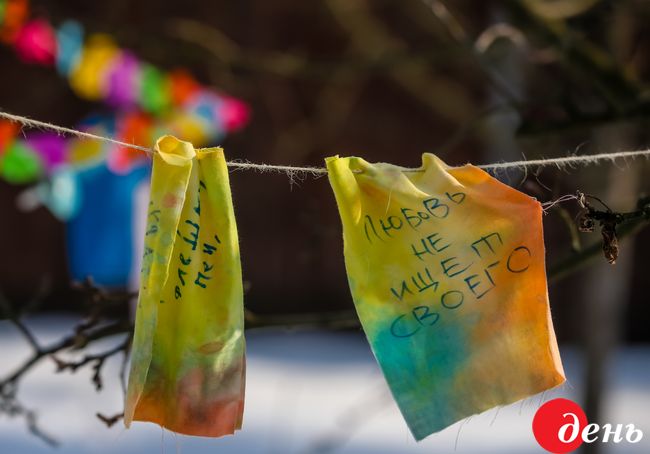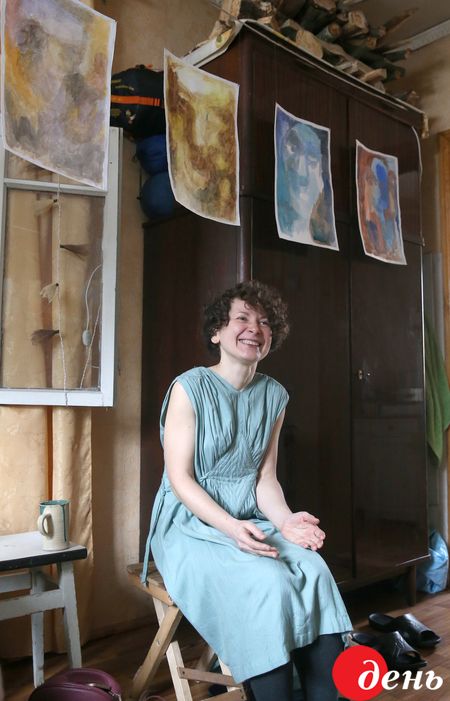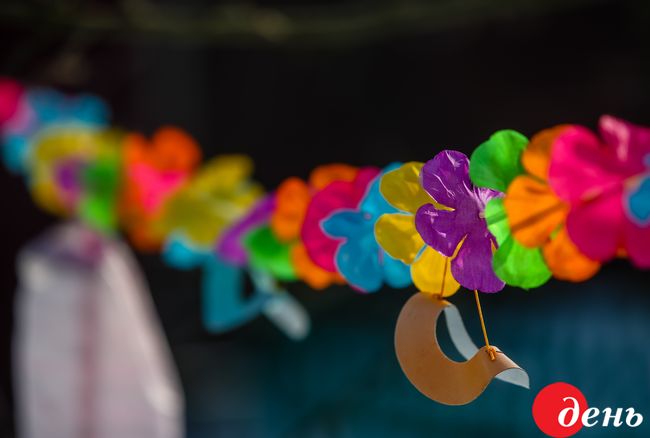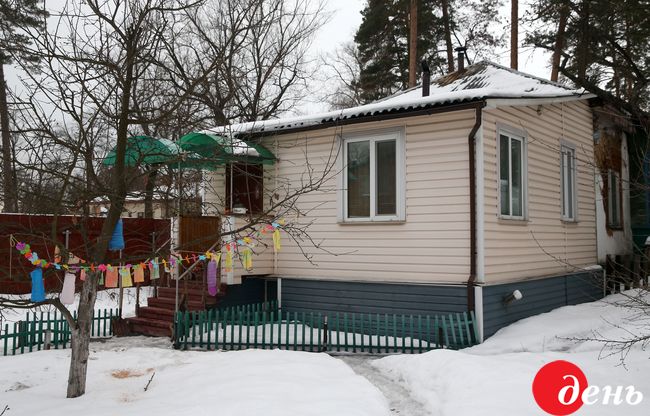“Here all life becomes art”
Residents of a “creative house” in Pushcha-Vodytsia know how to combine harvesting fuelwood and information technology
Pushcha-Vodytsia is commonly associated with mansions of Ukrainian officials and Soviet-era sanatoria. It is also a picturesque location for filmmaking and for walks, which can be easily reached from Kyiv, thanks to minibuses and a romantic tram that starts its journey from Kontraktova Square.
The wintry start of spring is not the best time to have some rest in Pushcha, but myself and our photographer did not go there for it. The Creative House has existed in Kvitky Tsisyk Street (formerly known as Pushkinska, Stalinhradska, and Hamarnyka) already for six months. One day, designer Oleksandr Haidai felt the need to work in a natural environment. He got so enthusiastic about the idea that he wanted to allow others to partake in it as well. Haidai told and showed The Day what came out of it.
EVOLUTION WITH AN AXE
“These flags appeared here three weeks ago,” he said pointing at colorful flags hanging on a branchy tree next to a small house. “I sing with the band Yedino Vsyo, we had a concert then, there were guests. It occurred to us to write down various wishes and mantras and hang them on a tree, as they do in Nepal. So we did it.”

There was a motley-colored cabin in the courtyard. Haidai laughed and called it the first art object of the Creative House. “There was no outhouse here at first, and I told the owner of the house that I would come and live here only after one appears. He built a shell, while I and my friends painted it,” the lad explained.
An axe was visible near the stairs. In winter, Haidai and Anna Demianova, who are joint masters in this project (that is, the people who care for the house daily), have to walk to the forest to get some fuelwood twice or thrice a week. “One of my goals was to get through the winter on my own fuelwood. I was also generally wondering how I was going to winter in a not-so-comfortable house,” the lad admitted. “I had to deal with heating issues, combat air drafts. Everything was being constantly improved. At first, we had a blunt axe, then we sharpened it, and later still bought a new one.”
AN IDEA IMPLEMENTATION SPACE
We entered a two-room house, where residents were going to talk about their achievements. It smelled of chocolate, as Haidai was making brownie dessert in a multicooker. The walls were decorated with colorful ornaments in the form of stairs made of painted sprigs, since Demianova, who is an artist, likes to make such things. The stock of fuelwood laid on the cabinet, the stove was turned off, but still warm. We sat down in a room decorated with 21 paintings, all belonging to a series inspired by the Gospel of John and created by Demianova.

“I recently reviewed my diary entries from 2003 or 2004 and was surprised by myself writing there that I wanted to create something like the Creative House. Over time, I forgot about it,” Haidai said. “For me, this house is a space where people can implement their ideas or projects, ranging from small to global, for example, ones aiming to change the education system.”
THE FIRST TRY
The idea of such a space was implemented for the first time about a year and a half ago. Before that, Haidai rented an apartment in Kyiv, and after the plan had taken shape, he began to gather those willing to come together at a house in Pushcha-Vodytsia. People from across Ukraine responded: a lad from Zaporizhia, a girl from Zolochiv, and a girl from Lanivtsi. Together with the designer, they rented a house in 14th Linia and lived there for four months.

In the first version of the Creative House, people lived together and held various meetings, where they discussed, for example, the features of graphic design or how to write a resume. They interacted with the local community as well. But, unlike the current Creative House, it was not obligatory to have a specific project and a plan for its implementation.
Haidai showed a picture of a garbage dump. “This is not us,” he laughed. “We saw that dump in a street. People came there and dumped everything they could. There are a lot of activists in Pushcha, so we cooperated with them to remove garbage. We did it for a month. We went there weekly and removed it little by little. We found syringes, a huge number of diapers and much more else there. On the last day of cleaning, we took away two truckloads of stuff. Also, we put a multicolored fence there. The owners of the site removed it afterwards. But now it is clean, we have fulfilled our task.”

ANNA DEMIANOVA SITS NEXT TO HER DRAWINGS, “PORTRAITS OF PHRASES” FROM ST. JOHN’S GOSPEL. THE ARTIST HAD MULLED OVER THIS PROJECT FOR A LONG TIME BUT MANAGED TO IMPLEMENT IT ONLY IN PUSHCHA-VODYTSIA, WHERE SHE HAD TO CARE ABOUT EVERYDAY THINGS AND CLEARLY PLAN HER DAYS
Besides, the residents of the first Creative House decorated an abandoned building in 3rd Linia in collaboration with local activists. They held an art picnic at a lake where artists and amateurs painted. Then five pictures were inserted into frames of the empty house. Now it adds color to the landscape of Pushcha.
The project has changed the lives of some of its participants. One lad decided to change his profession and become a psychologist, so he and his girlfriend went to the Polish city of Wroclaw, where he is studying now. Meanwhile, the girl studied design from scratch with Haidai and is now working in this area. The designer himself received an invitation to visit Canada and went there for several months. And when he returned, he decided to repeat the creative project in Pushcha-Vodytsia.
“THIS IS NOT A HOSTEL”
“I came to live in this house alone last summer and lived so for a few months,” Haidai recalled. “At first it was difficult, but everything was developing. Many friends came to visit me, I was teaching design. One of the first projects to happen here was the development of the website, which involved five designers. As a result, we changed our mind and abandoned the website project before it was to be launched, but we did develop the design, and my students improved their skills working on that project.”

Andrii Pyvovar was among early participants of the second Creative House. “Pyvovar had been working in a bank, sitting there in a cubicle. He grew fed up with it, went on a journey, and when he returned, he decided to switch to design,” Demianova said.
He studied design from scratch under Haidai for three months, starting in Kyiv before the second Creative House appeared, and subsequently moving to Pushcha. “Pyvovar aimed to practice the art until he hit the junior level and then find a job,” Haidai said. “I shared my experience with him for three months, we jointly created several projects for which he received money and added works to his portfolio. In early January, Pyvovar found a job with a design studio. This is my personal achievement as a teacher and one of the projects that have been implemented here.”
To get to join the Creative House, one generally needs to have a specific project and a plan for its implementation, including specific deadlines. It should be described in a Google form, and if its author and the founders of the project find each other acceptable, one may come and join. One has to pay for bed and board in the Creative House, but most importantly, one has to implement one’s plan. “If a person comes to just live here, it turns into a hostel, and that is not how it should be,” Haidai added. “But we do not press people. One participant of the project was not doing what he had been going to. We spoke to him about this, and he calmly went away.”

Once a week, all Creative House participants discuss everyday life and their projects together. As many as four people lived there for a time, while three are enough for comfortable living. However, a lot of people went through the small house during these six months: some stayed for several months, others came to attend meetings devoted to design and painting.
DEMIANOVA’S LEGEND
Just before our arrival, Demianova completed a painting class. She has conducted them regularly here for some time. The artist learned about the Creative House from a friend, came here to a concert on an occasion and realized: this was what she dreamed about.

“Five years ago or so, I spoke to my painting teacher. She said that it was cool to come up with a legend for one’s life. The only thing that would persist and remain in the memory of people for a long time,” Demianova recalled. “The teacher asked: ‘Do you have something like that? What can be the best thing to happen in your life?’ When I thought about it, I imagined a great house where there were many different workshops, people of different professions working there, making something, sharing experiences. I told my teacher about it. She did not take it seriously, said that it was something banal. Still, the opportunity to give someone space for creativity always seemed to me a precious resource. And when I found myself here, I saw that this small house with Spartan conditions could grow into something like that.”
The idea of an artistic project which she implemented in the Creative House had been present in Demianova’s mind for a long time. She has studied for seven years at a school where they teach the method of painting which was developed by the Swiss artist Gerard Wagner and builds on the properties of color. The artist calls her technique “the painting combined with a sense of the word.” The Gospel of John is the basis of two of her series. “I held my first Gospel-themed exhibition a year ago. It also included 21 works, but they were not portraits, unlike my current project. I read a certain verse from every chapter of this gospel and tried to feel what gesture or movement was inside of it. I then conveyed this movement through certain colors. Essentially, I painted portraits of phrases,” Demianova said.

The need to carefully plan the timing of her project became the main challenge of the Creative House for the artist. However, it turned out that such a demanding planning style stimulates creativity better than a free schedule.
“At first it seemed that I would not manage to do anything at all, as housework took all the time. But when I got more responsibilities, it added strength for my own project,” Demianova asserted. “When you find yourself in such conditions, all life becomes art. I looked at scattered fuelwood one day, and suddenly realized that it was an interesting material. The idea of creating decorated useful things from them occurred to me, because I love to paint on wood. I have also generally realized that it is cool to find beauty in some very ordinary things. Then the environment itself teaches you what the design and composition is. And this is something real. It is born from life itself, from necessity. After all, you do not have time to do something that is not necessary.”
COMMUNICATING WITH THE WORLD OUT OF THE MIDDLE OF A FOREST
Why have they chosen Pushcha-Vodytsia? “Locals say it is a place of power,” Haidai said. “There is a very positive energy field, clean air, and water here. When I arrived in Pushcha after a day’s work before, I fully recovered in just an hour. So I was really interested in finding out how it would be to live here.”
Currently, one of the goals of the Creative House’s founder is to find a third master who will also care about the house. Then they will be able to find a larger building, with separate rooms for organizers and participants. So far, residents of the Creative House pay for its upkeep out of their own wallets. Haidai observed: “I think that in the future, it will be possible to create our own products and sell them. These can be both material things and classes. We want to institute donations as well.”

In addition to design, Haidai has been working on a musical project for four months already, which is scheduled to be displayed in May. He is not disclosing any details so far. He also made a comic book about the liberation of Mariupol. “My work is modern in nature, I create projects for different countries. On the other hand, I live a rural life. When a client is calling, I say that I will be ready to meet him in half an hour, and then go out with an axe to cut some fuelwood,” the lad smiled. “The essence of the Creative House is to do something, to create specific things. In my opinion, the world is full of twaddle nowadays, and it would be desirable to see people’s actions matching their words.”

Newspaper output №:
№18, (2018)Section
Close up





